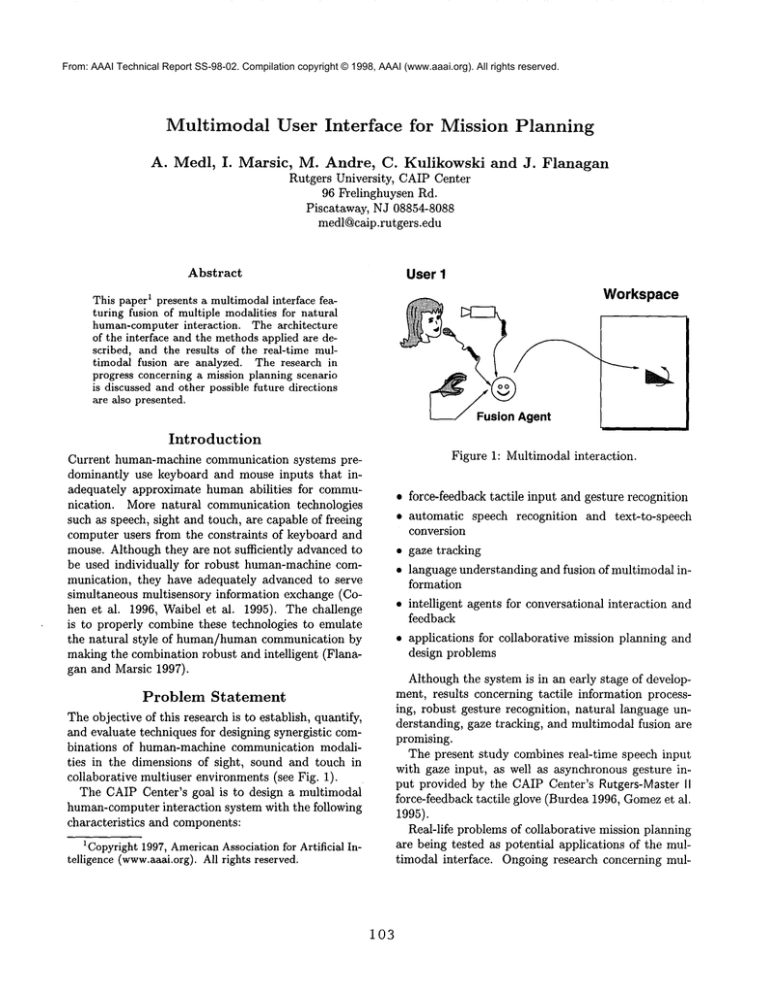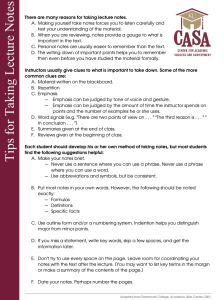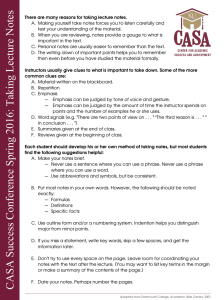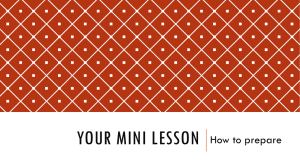Multimodal User Interface for Mission Planning
advertisement

From: AAAI Technical Report SS-98-02. Compilation copyright © 1998, AAAI (www.aaai.org). All rights reserved.
Multimodal User Interface
A. Medl,
I.
Marsic,
for Mission Planning
M. Andre, C. Kulikowski
Rutgers University, CAIP Center
96 Frelinghuysen Rd.
Piscataway, NJ 08854-8088
medl@caip.rutgers.edu
Abstract
and J.
Flanagan
User 1
Workspace
This paper1 presents a multimodalinterface featuring fusion of multiple modalities for natural
human-computerinteraction. The architecture
of the interface and the methodsapplied are described, and the results of the real-time multimodal fusion are analyzed. The research in
progress concerning a mission planning scenario
is discussedandother possible future directions
are also presented.
Fusion Agent
Introduction
Current human-machine communication systems predominantly use keyboard and mouse inputs that inadequately approximate human abilities
for communication. More natural communication technologies
such as speech, sight and touch, are capable of freeing
computer users from the constraints of keyboard and
mouse. Although they are not sufficiently advanced to
be used individually for robust human-machine communication, they have adequately advanced to serve
simultaneous multisensory information exchange (Cohen et al. 1996, Waibel et al. 1995). The challenge
is to properly combine these technologies to emulate
the natural style of human/human communication by
making the combination robust and intelligent (Flanagan and Marsic 1997).
Problem
Figure 1: Multimodal interaction.
¯ force-feedback tactile input and gesture recognition
¯ automatic speech recognition and text-to-speech
conversion
¯ gaze tracking
¯ language understanding and fusion of multimodal information
¯ intelligent agents for conversational interaction and
feedback
¯ applications for collaborative mission planning and
design problems
Although the system is in an early stage of development, results concerning tactile information processing, robust gesture recognition, natural language understanding, gaze tracking, and multimodal fusion are
promising.
The present study combines real-time speech input
with gaze input, as well as asynchronous gesture input provided by the CAIPCenter’s Rutgers-Master II
force-feedback tactile glove (Burdea 1996, Gomezet al.
1995).
Real-life problems of collaborative mission planning
are being tested as potential applications of the multimodal interface. Ongoing research concerning mul-
Statement
The objective of this research is to establish, quantify,
and evaluate techniques for designing synergistic combinations of human-machine communication modalities in the dimensions of sight, sound and touch in
collaborative multiuser environments (see Fig. 1).
The CAIPCenter’s goal is to design a multimodal
human-computerinteraction system with the following
characteristics and components:
1Copyright1997, AmericanAssociation for Artificial Intelligence (www.aaai.org).All rights reserved.
103
timodal manipulation of icons on military maps is reported.
First, we briefly describe the functional system components. Then, the methods applied for language processing and sensory fusion are introduced and research
progress is outlined.
System
Components
RM-II Force-Feedback
Tactile
Glove
The Rutgers Master II (RM-II) system is a portable
haptic interface designed for interaction with virtual
environments (Burdea 1996). Its two main subsystems,
shown in Fig. 2, are the hand-master and the Smart
Controller Interface (SCI).
grab : used for grabbing and moving the selected object;
RM-IIHandMaster
thumbup : associated with resizing the selected object;
\
Pneumatic
actuator
Non-contact
SmartControllerInterface
Hoarcomputer
gesture module features only natural hand gestures in
an effort to create an easy-to-use interface (Pavlovic et
al. 1997).
The first step in designing the hand gesture module involves implementing an object selection function.
In a 2D environment, the coordinates are calculated
where a virtual ray along the user’s index finger intersects the screen plane and outputed when the corresponding gesture ("pointing") is executed. The selection point is further checked to see if it is inside any
object in the environment. Other gestures designed for
object manipulation are:
open hand : corresponds to the ’unselect’ or ’drop
object’ command;it is also used as a reset position
for hand gestures;
\
curling the thumb : corresponds to mouse clicks.
user hand
Gloveposition
Figure 2: The Rutgers Master-II force-feedback tactile
glove.
i ..................rg n-iqa;,g’
Gazeposition
The RM-II hand master can read hand gestures (fingertip positions relative to the palm) and apply forces
on the fingertips corresponding to the interaction.
The hand-master unifies hand motion sensing and
force display in a small, compact structure weighing
80 grams. The main structure consists of a small
"L" shaped palm base on which four custom-designed
linear-displacement pneumatic actuators and 8 Halleffect sensors are mounted. The actuators are equipped
with a special sensor to measure their linear displacement. A 6D Polhemus tracker (Polhemus 1993)
mounted on the back of the hand provides wrist position/orientation.
=l,
Gaze tracker
HandGestures
Reading
Hand gesture
module
The hand gesture module is implemented using the
RM-II system described above. Hand gesture input is
particularly efficient for two kinds of tasks: 3Denvironment surfing (changing the viewpoint of virtual environment) and virtual objects manipulation. Since the
glove was used in this application in a 2D graphic environment, only gestures for object manipulation were
implemented. In addition, a special gesture was defined to emulate mouse clicks (to maintain compatibility with current GUI’s). The design of the hand
<commands> <{~J’~
~ Software Agent
Figure 3: Hand gesture interaction
and glove display.
Oncea hand gesture is recognized, the corresponding
string is generated and sent to the parser as indicated
in Fig 4. In addition, a separate stream is continuously
sending hand-pointing screen coordinates.
Gaze tracker
The gimbal mounted gaze tracker (ISCAN 1994) consists of a camera and an infrared illuminator.
The
illuminator projects infrared light into the left eye of
104
the user while a sophisticated image processing software continuously analyzes the video image and tracks
the gaze by computing the angle between the centroid
of the pupil and the corneal reflection.
After proper calibration the gaze tracker outputs xy screen coordinates. These coordinates are forwarded
to the fusion agent for further analysis and to the application, where an eye-cursor is continuously displayed
on the screen.
Speech
Recognizer
The current system uses a Microsoft speech recognizer
engine (Microsoft 1996) with a finite-state
grammar
and a restricted task-specific vocabulary. The recognition is speaker-independent.
Once the speech recognizer has recognized a phrase,
it sends the text to the parser together with two timestamps. Although the current recognizer does not provide time-stamps after each word, it does provide the
time at the start and end of each utterance. In future
applications - to achieve temporal synchronization of
the modalities -, time-stamps after every word of the
utterance will be necessary to exactly determine where
the user is pointing at (with tactile glove or gaze) while
speaking.
Furthermore, the Whisper system exclusively runs
under Microsoft Windowsand is not portable to different platforms. Therefore, a CAIP-developed recognizer (Lin 1996) will be applied to solve these problems.
Microphone
Array
CAIP’s microphone array technology liberates the user
from body-worn or hand-held microphone equipment,
permitting freedom of movement in the workplace.
The current fixed focus line microphone array focuses
on the speaker’s head sitting approximately 3 feet from
the monitor. Other sound sources are successfully attenuated. A CAIP-developed microphone array system
is applied as a robust front-end for the speech recognizer to allow distant talking (Lin 1996).
Language Processing and Sensory
Fusion
Parser
The first step in the understanding of multimodal commands involves parsing of the sensory inputs. In our
system, the parser communicates with each modality
and the fusion agent as illustrated in Fig 4. The reason for communicating through the parser is that we
have chosen spoken language as the commonmeans of
communication. Gesture information provided by the
tactile glove is first translated into written text by the
gesture recognition module, and forwarded for further
105
analysis to the parser. Note that this process is similar
to the translation of sign-language gestures into their
spoken language representations.
In the test application, the initial task-specific vocabulary is small and contains about 150 words. We
implemented a simple context-free grammar as shown
below. The following code fragment uses a common
syntax in which:
¯
¯
¯
¯
capitalized identifiers are non-terminals
parenthesized identifiers are terminal symbols
alternatives are separated by the symbol [
a non-terminal between rectangular brackets [ ] is
optional
¯ PHRASEis the start symbol
PHRASE
= [ REDUNDANT] META_PHRASE[ REDUNDANT]
I [ REDUNDANT] CMD PHRASE [ REDUNDANT]
I NOUN_PHRASE
I PREP_PHRASE
[ REDUNDANT
REDUNDANT
--"can you" I "please" I "I want to"
I "0K" ] "with"[ "of"
META_PHRASE
= "no" I "undo" I "undo last command"
I "forgetit" I "leaveit" I "end"
CMD_PHRASE
= CMD_VERB[ NOUN_PHRASE
]
[ PREP_PHRASE
]
[ PREP_PHRASE
]
CMD_VERB = "move" I "relocate"
i "remove"i "delete"
"resize"
"draw" I "create"
"place"I "put"
NOUN PHRASE
= [ ARTICLE] [ MODIFIER] 0BJ_TYPE
I POSITION_SPEC
ARTICLE= "a" I "an" I "the"
MODIFIER=C0LOR [ SIZE ]
I SIZE [ C0LOR]
I
"new"
COLOR = "red" I "green"I "blue" I "black"
understanding is often encoded in structures called
frames. In its most abstract formulation, a frame is
simply a cluster of facts and objects that describe some
typical object or situation. In our application, frames
contain information about commandsgiven by multiple modalities, such as tactile glove and speech inputs.
A similar architecture is described in (Shaikh 1996).
The principal objects in a frame are assigned names,
called slots. For example, the commandframe "delete"
contains only one slot called "object ID," while the
frame "create" should contain slots called "object
type," "color," etc. The slots can be viewed as functions that take values to instantiate the actual frame.
Thus a particulax instance of a frame represents a
structured set of knowledge.
Our approach to multimodal fusion is illustrated in
Fig. 4. Weare using a predefined set of frames corresponding to the possible commandsin the current application. A slot writer-reader method which installs
and retrieves slot values has been implementedas part
of the fusion agent module. It uses the keyword approach combined with some grammar constraints.
SIZE = "short"J "small"
J "big" J "large"J "long"
OBJ_TYPE= "rectangle"i "box"
I "circle"i "oval"
i "line"
PREP_PHRASE= PREPOSITIONPOSITION_SPEC
PREPOSITION
= "to" i "from" I "at" I "through"
i "passingthrough"i "till"
I "up till"I "up to"
POSITION_SPEC = "here" I "there"I "this
position"I "this point"
i TERRAIN_FEATURE
TERRAIN_FEATURE-"hill"ID I "camp"ID
= "with gaze" I "with glove"
MODALITY
As mentioned above, synchronization of speech and
gesture is essential in future developments. Currently,
glove positions needed for the application axe indicated
by pointing gestures of the tactile glove and forwarded
to the parser as position specifiers. Also, the position
of the eye-cursor is forwarded to the parser.
Multimodal
Fusion
Our approach to multimodal fusion is a variation of
the slot-filler methodwhich is well-knownin artificial
intelligence (Winston 1992, Allen 1995).
Slot Buffer. An important component of the fusion
agent is the slot buffer. It stores the incoming values
for all possible slots defined by the commandvocabulary. This is essential because present information is
often used in the future. Consider this example: the
user selects an object by saying "Select the green circle." Next, he can say "Moveit." If the object from the
previous utterance is stored in a slot buffer, then the
"Move it" commandhas sufficient information about
what to move. In other words, the slot buffer contains
memoryof past operations.
Modalities
MfCROPHONE
ARRAY
Fusion
Agent
lO0 000
Application
(Drawing
Program)
Display
glove
Figure 4: Integration of tactile glove, speech, and gaze
input in a collaborative application.
Information
necessary
for command or language
106
Slot Filling
and Command Execution.
The
parser fills the slots in the slot buffer that are des-
ignated in the utterance using the slot-writer method
and reads the tactile glove positions and gestures when
appropriate.
For example, the utterance "Fromhere to here create
a red rectangle," causes the following slots to be filled
in the slot-buffer: the positions of the two opposite
corners of the object, the object’s type, the object’s
color, and the operation or commandtype.
On the other hand, if only the gesture recognition
moduleis providing information, the parser relies only
on that input. In the current design, complementarity
and concurrency problems are handled on a first-come
first-serve basis. The system executes a commandas
soon as all necessary information is available. The information may be provided entirely or partly by either
modality.
The instantiation of a particular commandframe is
done by analysis of information in the slot buffer. A
demonmonitors the slot buffer to determine if the commandslot is filled. If it is not filled, the systemwill wait
for more input information provided by any modality.
If the commandslot is filled, the demonwill instantiate the corresponding commandframe and examine
if there is sufficient informationin the slot-buffer to fill
each predefined slot of that particular frame. The demonmust of course wait until all slots are filled. Then
the commandwill be executed through the application
programming interface (API).
To achieve maximumflexibility,
the design assures
that a particular frame contains the minimumnumber
of slots that are necessary to unambiguously execute
a command.For example, if there is a blue rectangle
and a red circle in the workspace, it is sufficient to
say "delete the rectangle" because the "delete" frame
only contains the minimumnecessary information i.e.,
the "object ID" slot. The utterance "delete the large
blue rectangle" generates the same commandbecause
it obviously contains the minimuminformation needed
for the intended action.
If the command
slot of the slot buffer is not filled by
the parser, then the system will wait for more input
information provided by either modality.
Results
ing, moving,resizing, deleting, etc.) colored geometric
objects and icons on topographical maps.
Fig. 5 illustrates
how colored objects can be manipulated using simultaneous speech, gaze, and tactile
input. Figs. 6 and 7 show icons being moved by a
commandgenerated by multiple modalities. Here, "helicopter 96" is selected and movedby the "grab-move"
gesture, gaze, and speech.
Figure 5: Manipulation of colored objects by speech
and gesture in a collaborative drawing program.
Research
in
Progress
Weintend to integrate a gaze-tracker to select and manipulate objects, adding further flexibility to the sensory input.
Weare also proposing to investigate the possibility of
a gesture recognition agent design to interpret possible
commandsgiven by gaze sequences.
A three-dimensional graphical environment will be
implemented to simulate 3D problems, tissue palpation, and other medical applications.
An intelligent information agent is being designed
to answer queries and provide information to the user
about the actual state of the workspace(e.g., contents,
positions and types of icons, history of past operations,
etc.). This will be a crucial element of a mission planning system which could be applied to disaster relief
or rescue operations.
Text-to-synthetic speech answerbackto the user will
include notification about unrecognized phrases and
unexecutable operations as well as acknowledgment of
commands.
An important aspect of networked multimodal systems is collaborative work. The DARPA-sponsoredeffort Distributed System for Collaborative Information
Processing and LEarning (DISCIPLE)has already resulted in a framework for multiuser collaboration. We
and Discussion
Our current testbed uses a 150-word vocabulary with a
finite grammarand a force-feedback tactile glove. The
speech recognition works adequately for distant talking
due to the microphonearray. The fusion agent with the
slot-buffer performs well even for asynchronous inputs
from modalities. The commandexecution in the collaborative drawing program operates without substantial delays when tested in our laboratory. However,its
current functionality is limited to manipulating (creat-
107
are planning to apply the methods of multimodal
human-computer interaction in collaborative and cooperative work in the near future.
Figure 7: Manipulation of military icons by speech and
gaze in a collaborative environment.
feedback to the user.
Figure 6: Manipulation of military icons by speech and
gesture in a collaborative environment.
A mission planning scenario is being designed to
evaluate the multimodal collaborative system. Geographical information is represented in map-tile format
similar to that of the MARCO
system (Samet and Soffer 1996), In order to achieve interactivity, the user
should be able to indicate self-defined regions with the
tactile glove pointer and speech. For example, the utterance "now I am indicating camp number six" results in activating a recording program which fills in
appropriate map-tiles with information while the user
simultaneously leads the pointer along the region to be
defined as "camp number six." The utterance "finish
recording" deactivates the recording program. The information is stored in memory,so the user can refer to
that region (e.g., "movetank four six to camp number
six").
A structure for knowledgerepresentation is being designed to include a description of a) the map-content
(i.e., topographical or man-madefeatures) which is expected to remain invaxiant during a problem-solving
session, b) the icons expected within the session, including their attributes and hierarchical decomposition
into subicons, c) rules constraining the expected and
allowed behavior of icons within the map-context.
Various architectures for the intelligent fusion agent
(probabilistic decision networks, adaptive classification
and neural networks) axe being considered to achieve
robust and intelligent
commandinterpretation
and
108
Acknowledgment
The authors had helpful discussions with Professors G.
Burdea and J. Wilder. Special thanks to G. Popescu,
A. Shaikh, and Y. Liang for their assistance in system
implementation.
Components of this research are supported by
NSF Contract No.IRI-9618854,
DARPAContract
No.N66001-96-C-8510, and by the Rutgers Center for
Computer Aids for Industrial Productivity (CAIP).
CAIP is supported by the Center’s corporate members and the NewJersey Commission on Science and
Technology.
References
Books
Allen, J. 1995. Natural Language Understanding, California: The Benjamin/Cummings Publ. Co.
Burdea, G. 1996. Force and Touch Feedback for Virtual Reality, NewYork: John Wiley & Sons.
Winston, P.H. 1992. Artificial Intelligence, 3rd edition, Addison-Wesley Publ. Co.
Journal
Article
Pavlovic, V.I.; Shaxma, R.; and Huang, T.S. 1997.
Visual interpretation
of hand gestures for humancomputer interaction:
A review. IEEE Transaction
on Pattern Analysis and Machine Intelligence, 19(7).
Samet, H.; and Softer,
A. 1996. MARCO:MAp
Retrieval by COntent. IEEE Transaction on Pattern
Analysis and MachineIntelligence, 18(8):783-798.
Waibel, A.; Vo, M.T.; Duchnowski, P; and Manke,
S. 1995. Multimodal Interfaces. Artificial Intelligence
Review, 10(3-4).
Proceedings
Papers
Cohen, P.R.; Chen, L.; Clow, J.; Johnston, M.; McGee,
D.; Pittman, J.; and Smith, I. 1996. Quickset: A Multimodal Interface for Distributed Interactive Simulation. In Proceedings of the UIST’96 demonstration
session, Seattle.
Flanagan J.L.; and Marsic, I. 1997. Issues in
Measuring the Benefits of Multimodal Interfaces.
In Proceedings of the IEEE International
Conference on Acoustics, Speech, and Signal Processing
(ICASSP’97), Munich, Germany.
Gomez, D.; Burdea, G.; and Langrana, N. 1995.
Modeling of the RUTGERSMASTER-II haptic display. In Proceedings of ASMEWAM,DSC-Voh57-2:
727-734.
Lin, Q.; Che, C-W.; Yuk, D-S.; and Flanagan,
J.L. 1996. Robust Distant Talking Speech Recognition. In Proceedings of the IEEE International Conference on Acoustics, Speech, and Signal Processing
(ICASSP’96), Atlanta, GA, pp.21-24, May 1996.
Shaikh, A.; Juth, S.; Medl, A.; Marsic, I.; Kulikowski C.; and Flanagan, J.L. 1997. An Architecture
for Fusion of Multimodal Information. In Proc. Workshop on Perceptual User Interfaces, Banff, Alberta,
Canada.
Technical
Reports
ISCAN,Inc. 1994. Operating Instructions.
Polhemus, Inc. 1993. Fastrak User’s Manual. Colchester, VT.
109



